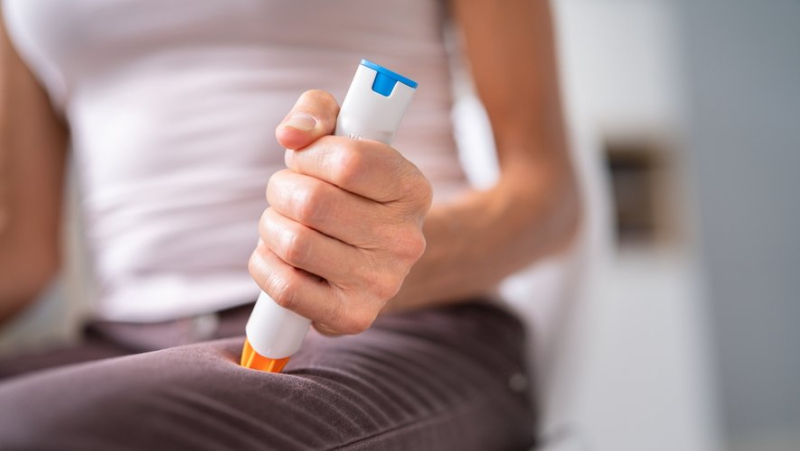Food allergies: schools soon to be equipped with adrenaline auto-injectors ?

Food allergies: adrenaline auto-injectors in schools ?
About 10% of food anaphylaxis – an acute and serious allergic reaction – occurs in a school setting. For almost half, these are the first manifestation of a previously unknown allergy. Adrenaline is the effective treatment, provided it is injected immediately. Hence the idea of equipping schools with it.
Anaphylaxis is the most severe manifestation of allergy, generalized throughout the body. Nearly 5% of people with allergies are affected. Anaphylactic shock is itself the most severe form of anaphylaxis, an absolute medical emergency.
60% of cases of anaphylaxis are of food origin
Anaphylaxis has been increasing for around twenty years, particularly linked to diet in children. Food is in fact the main cause of anaphylaxis (60% of cases), ahead of hymenoptera (wasps…). Any food protein is a potential allergen (we speak of a trophallergen).
In 2019, the Director General of School Education (DGESCO) issued a note intended for rectors and heads of secondary schools, recommending that they make adrenaline auto-injector pens available , easily accessible, and to train staff. Objective: to guarantee easier access to adrenaline and treat allergic reactions occurring in educational establishments, in particular cases of initial anaphylaxis after medical advice from the SAMU.
As a reminder, adrenaline is an effective treatment for multisystem allergic reactions (affecting the cardiovascular, respiratory, cutaneous systems…) with rapid action on cardiovascular and respiratory symptoms.
An inconclusive school assessment
An evaluation of this measure was carried out by Dr Clarisse Santos (pediatric pulmonology and allergology, Lille CHRU), member of the "Allergy at school" of the French Society of Allergology, in the Nord and Pas-de-Calais, from March to April 2023. It was presented at the French Congress of Allergology 2024 (Paris, April 16-19, 24).
Among the responders, 72% have installed a box of 2 adrenaline auto-injector pens in their establishment. For those who did not do so, the reasons were that it expired too quickly (28%) and the cost was too high (26%). In 70% of cases, storage was planned in the infirmary, in an administrative location in 43% of cases and in the canteen in 25% of cases. All school staff had access to it in only 48% of cases. In cases where they were only accessible to authorized personnel, they were locked in 89% of cases!
20% of establishments had difficulty training their staff, either because they felt that it was not their responsibility to recognize and treat anaphylaxis (43 %), either because of organizational problems (37%) or linked to the fear of injecting the product incorrectly (24%). It is therefore a mixed result: adrenaline is not permanently accessible in at least half of the cases, which greatly limits its usefulness.
If the benefit of all schools equipping themselves with adrenaline pens remains debated given the available scientific literature, it has been shown that a food allergic person who has already had an anaphylactic reaction must always have an adrenaline injector pen near or on your person.
When in doubt, do not refrain!
"The adrenaline injection is a vital reflex in cases of suspected anaphylaxis, but it is unfortunately still underused , regrets Dr Etienne Beaudouin, from the Anaphylaxis Group of the French Society of Allergology (Regional Institute of Allergological and Environmental Diseases and Clinical Immunology, CHR Metz-Thionville). When in doubt, about yourself or a third person, you absolutely must not abstain! The time for the maximum plasma concentration of adrenaline is 8 minutes, plus or minus two minutes, provided it is injected intramuscularly and early, when the circulatory flow is sufficient.< /em>"
Adrenaline is reimbursed on medical prescription and delivered with two self-injectable pens. "Each auto-injector pen has its handling characteristics which will be explained by the doctor to the patient and those around them, adds the allergist. The prescribed model must therefore not be substituted by the pharmacist". Concretely, the adrenaline injection is carried out on the antero-external face (front and slightly to the side) of the middle third of the thigh, intramuscularly, ideally directly on the skin (failing that, through clothes).
The pen should be held at an angle of 90° relative to the thigh for 5 to 10 seconds, depending on the device. The injection works within a few minutes. Without any improvement in symptoms, it should be repeated within 5 to 10 minutes. You must then call emergency services for hospital treatment.
To find out more: Guide for allergic children – 2018 edition by the Asthma & allergies




